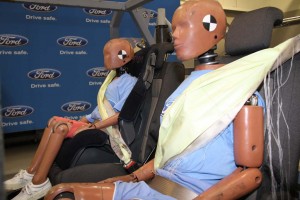
These child-sized crash dummies are wearing the new inflatable seatbelts Ford will introduce on the 2011 Explorer sport-utility vehicle.
What happens when you combine an airbag and a seatbelt? Motorists will have the chance to find out, next year, when Ford Motor Co. launches the next-generation Explorer sport-utility vehicle, which will offer the world’s first inflatable seat belts.
The technology, which initially will be offered as an option on the 2011 SUV, will eventually roll out across Ford’s global product line-up, said the automaker’s director of safety, Sue Cischke.
The inflatable belts “could help reduce head, neck and chest injuries,” explained Cischke, particularly among young children and the elderly, who are especially vulnerable to the impact forces of an automobile accident.
Under development since 1998, the system appears, at first glance, much like a conventional 3-point seatbelt, though a bit softer and thicker, and with a different sort of latch mechanism.
Inside the webbing is, essentially a long, narrow balloon. If the vehicle’s crash sensors pick up a strong enough pulse – typically from an impact of at least 8 mph – that triggers the release of a compressed mixture of argon and helium gas, stored in a tank beneath the seat. That’s in contrast to the pyrotechnic system used by a conventional airbag, in which a solid charge is ignited, releasing a hot, rapidly expanding gas.
Once the Ford system is triggered, the gases flow through the modified latch, essentially a narrow pipe, into the shoulder portion of the seatbelt. That causes a seam to burst, the balloon-like airbag bursting out.
The bag/belt combination inflates in about 40 milliseconds, a good bit slower than a frontal or side-impact airbag. That’s more than enough, however, to help cushion crash forces – and without the risk of the inadvertent injuries sometimes caused when a conventional airbag triggers and inflates at a speed that can approach 200 mph.
The system, noted Paul Mascarenas, Ford’s vice president of engineering, “is designed to spread crash forces across five times the body area that traditional seatbelts do.” And that, said Dr. Stewart Wang, a professor of surgery and accident injury researcher, at the University of Michigan, means a far lower likelihood of injury to the elderly and the extremely young, both groups far more likely to suffer injuries in a crash.
Because such passengers are more likely to sit in the rear of a vehicle, Ford will offer the inflatable belt as a rear seat option. The automaker isn’t saying how much it will charge for the inflatable belts but a well-placed source told TheDetroitBureau.com that it will likely come in below the price of the automaker’s voice-activated Sync infotainment system, perhaps in the range of $250.
Ford isn’t the only automaker working on an inflatible belt. Lexus will offer something similar on the upcoming LF-A supercar, but there will be some differences in application. The Lexus is a 2-seater capable of topping 200 mph, and company engineers believe the belts will add an additional level of protection to the LF-A’s basic airbag system.
Only about 500 copies of the supercar will be built, with the first set to reach dealers at the very end of next year.
The first application, in the all-new Explorer, will come in the second half of 2010. But according to Cischke, the goal is to add more model lines while also spreading the technology to Ford products available elsewhere in the world.
“We’re planning to go across the fleet,” said Cischke.
Ford isn’t the only automaker working on an inflatable belt. Lexus will offer something similar on the upcoming LF-A supercar, but there will be some differences in application. The Lexus is a 2-seater capable of topping 200 mph, and company engineers believe the belts will add an additional level of protection to the LF-A’s basic airbag system.
Only about 500 copies of the supercar will be built, with the first set to reach dealers at the very end of next year.
